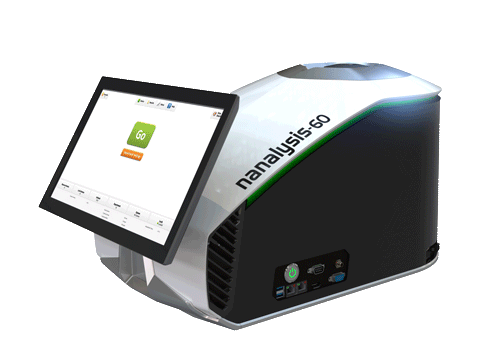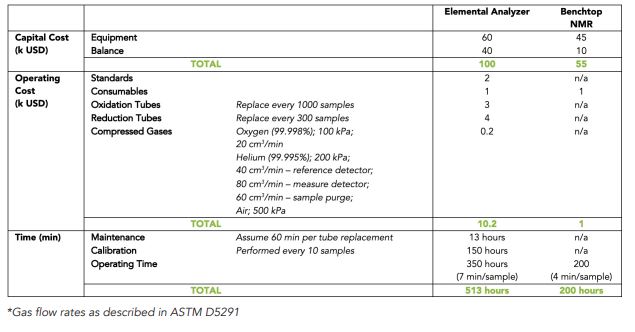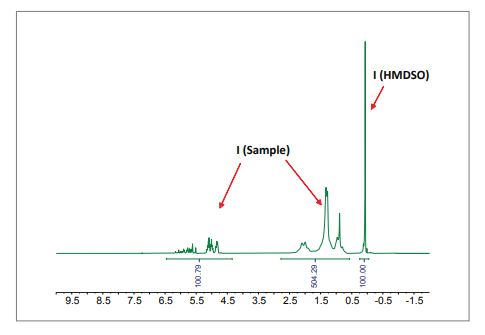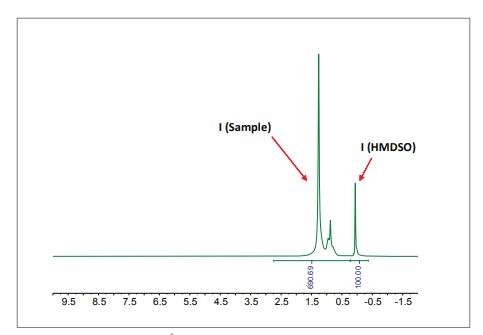Blog Standard

Precision Hydrogen Content in Crude Oil Analysis with NMR Spectroscopy
Determining the hydrogen content in crude oil is vital for assessing petroleum quality testing and optimizing the uses of crude oils in refining and combustion processes. Nuclear magnetic resonance (NMR spectroscopy analysis) offers a robust, efficient alternative to traditional methods like ASTM D5291, enabling precise hydrogen analysis of paraffins, naphthenes, and aromatics. This blog explores how Nanalysis’ High-performance 60 MHz 1H NMR Spectroscopy simplifies crude oil analysis.
Importance of Hydrogen Analysis in Crude Oils
The hydrogen content in crude oil, typically ranging from 9–16 wt% per ASTM D5291, directly influences combustion efficiency, making it a critical parameter in petroleum quality testing. Traditional ASTM D5291 methods rely on elemental analyzers, requiring compressed gases and frequent maintenance, which increase costs and complexity (Table 1). In contrast, 1H NMR spectroscopy provides a quantitative, non-destructive approach to hydrogen analysis, capturing signals from paraffins, naphthenes, and aromatics in a single spectrum. This method’s simplicity and in-house applicability reduce operational costs and turnaround times, enhancing efficiency in crude oil analysis.

Nanalysis 60 Benchtop NMR Spectrometer
Table 1. Comparison of running 3000 samples between elemental analysis (EA) (following ASTM D5291 for hydrogen content analysis in oils), and benchtop nuclear magnetic resonance (NMR) spectroscopy.

Method: NMR Spectroscopy Analysis with Internal Calibrant HMDSO (Figure 1, Table 2)
Using a Nanalysis 60 PRO instrument at 60.73 MHz, 1H NMR spectroscopy was applied to measure hydrogen content in crude oil analogs, 1-octene and undecane. The method employed hexamethyldisiloxane (Internal Calibrant HMDSO) as a reference for quantitative integration. Spectra were acquired at 32°C with a spectral width of 40 ppm, 8 scans, and a 23-second interscan delay. Integration regions for the sample and HMDSO were used to calculate hydrogen content via a specific equation (Figure 1). Results for 1-octene (average 14.33%) and undecane (average 15.84%) closely matched theoretical values (14.37% and 15.47%, respectively), with relative standard deviations (RSD) of 0.6% and 0.5% (Table 2). This demonstrates the accuracy and reproducibility of High-performance 60 MHz 1H NMR Spectroscopy for hydrogen analysis.



Figure 1 Representative 1H NMR spectrum of 1-octene (top) and undecane (bottom) in CDCl3. The integration regions used in the equation above, namely I (Sample) and I (HMDSO), are highlighted.
Table 2. Results of hydrogen content determination using the 60 MHz benchtop NMR for 1-octene and undecane.
| Hydrogen Content (%) | ||
|---|---|---|
| 1-Octene | Undecane | |
| Run 1 | 14.39 | 15.81 |
| Run 2 | 14.38 | 15.93 |
| Run 3 | 14.23 | 15.78 |
| Average (A) | 14.33 | 15.84 |
| Theoretical (B) | 14.37 | 15.47 |
| Difference (A-B) | -0.04 | 0.37 |
| RSD | 0.6 | 0.5 |
Conclusion: Advancing Crude Oil Analysis with NMR
Nuclear magnetic resonance using 1H NMR spectroscopy revolutionizes hydrogen content in crude oil determination, offering a faster, cost-effective alternative to ASTM D5291. The Nanalysis High-performance 60 MHz 1H NMR Spectroscopy system, with Internal Calibrant HMDSO, ensures precise crude oil analysis of paraffins, naphthenes, and aromatics, supporting petroleum quality testing and optimizing uses of crude oils. Its benchtop design enables in-house testing, reducing reliance on external labs.
Inkarp Instruments acts as a reliable distributor and service provider Hitachi products in India, offering advanced scientific solutions tailored to the dynamic requirements of modern research. With a commitment to excellence and trustworthiness, we enable researchers across India with state-of-the-art technology and dedicated support to advance innovation and discovery.
References:
[1] All, I.; Basit, M. A. Int. J. Hydrogen Energy 1993, 18, 1009-1011.
[2] Drews, A. W. Manual on Hydrocarbon Analysis (ASTM D5291): 6th Edition; American Society for Testing and Materials, 1998, 852-856.
[3] Mondal, S.; Kumar, R.; Bansal, V.; Patel, M. B. J. Anal. Sci. Technol. 2015, 6, 1-10.
[4] Bharti, S. K.; Roy, R. Trends Anal. Chem. 2012, 35, 5-26.

